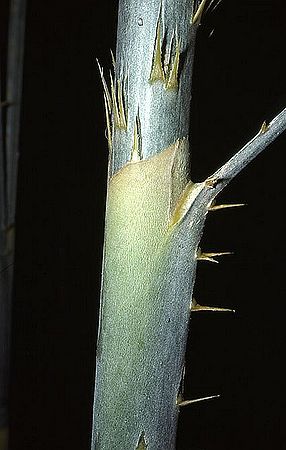Plectocomiopsis mira
| Plectocomiopsis (plehk-toh-KOHM-ee-ohp-siss) mira (me-RAH) | |||||||
|---|---|---|---|---|---|---|---|
 Central Catchment Nature Reserve; Lornie Trail; 2010. Photo by Dr. Teo Siyang. | |||||||
| Scientific Classification | |||||||
| |||||||
| Synonyms | |||||||
|
| |||||||
| Native Continent | |||||||
|
| |||||||
| Morphology | |||||||
| |||||||
| Culture | |||||||
|
| |||||||
| Survivability index | |||||||
|
| |||||||
| Common names | |||||||
|
| |||||||
Contents
Habitat and Distribution
Borneo, Malaya, and Sumatera. A local rattan found in scattered localities throughout Brunei. It grows in lowland and hill dipterocarp forest on a variety of soils at altitudes up to 800 m above sea level. Elsewhere in scattered localities in Borneo, Sumatra and Peninsular Malaysia..Description
Moderately robust high-climbing rattan with stems to 40 m; stem without sheaths slightly triangular in section, 15-20 mm diam., with sheaths to 35 mm, internodes to 40 cm in juvenile shoots, less in mature climbing stems. Sheaths rich bright green, with a thin covering of silvery grey indumentum and very sparse spines or unarmed; knee absent; ocrea very conspicuous, to 3 cm, orange-yellow, truncate, horizontal not tattering. Leaf to 2.75 m including the cirrus to 1.25 m; leaflets c. 9 on each side of the rachis, broad, spathulate, to 30 × 7 cm, bright green. Inflorescences produced simultaneously from the topmost about 5-10 nodes, male and female superficially similar but the male more finely branched, to 30 cm, with curving ± divaricate branches. Fruit ± oblate, about 2.5 × 3 cm, covered in 30 -35 vertical rows of bright orange-brown scales. Seed about 2 × 2 cm with thin sarcotesta. Seedling leaf bifid with very thin texture. (J. Dransfield, The Rattans of Brunei Darussalam. 1997)/Palmweb. Editing by edric.
The lack of a knee and the curious ocrea set this and P. triquetra apart from other rattans in Brunei; P. triquetra is more slender than P. mira, usually has more spines on the leaf sheath, the ocrea is longer on the side opposite the petiole, the leaflets are more slender and the plant is known only in peat swamp forest and kerapah. Vegetatively P. mira is identical to P. corneri Furt. of Peninsular Malaysia and can only be identified with certainty when inflorescences are available. (J. Dransfield, The Rattans of Brunei Darussalam. 1997)
Culture
Cold Hardiness Zone: 10a
Comments and Curiosities
Etymology: The specific epithet is from the latin; Surprising.
- IMAGE GALLERY
External Links
- Glossary of Palm Terms
- MODERN BOTANICAL LATIN
- "Just To Be Clear"
- MANG-UHAN, GRACE M. OCTOBER 2007. Insect Pests Associated with Rattan (Plectocomiopsis mira Dransfield) in Ifugao. Benguet State University, La Trinidad, Benguet.
References
Phonetic spelling of Latin names by edric.
Special thanks to Geoff Stein, (Palmbob) for his hundreds of photos.
Special thanks to Palmweb.org, Dr. John Dransfield, Dr. Bill Baker & team, for their volumes of information and photos.
Glossary of Palm Terms; Based on the glossary in Dransfield, J., N.W. Uhl, C.B. Asmussen-Lange, W.J. Baker, M.M. Harley & C.E. Lewis. 2008. Genera Palmarum - Evolution and Classification of the Palms. Royal Botanic Gardens, Kew. All images copyright of the artists and photographers (see images for credits).
J. Dransfield, The Rattans of Brunei Darussalam. 1997
Many Special Thanks to Ed Vaile for his long hours of tireless editing and numerous contributions.













